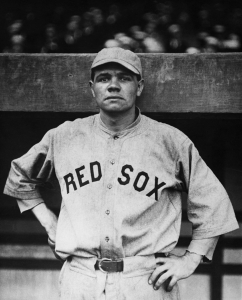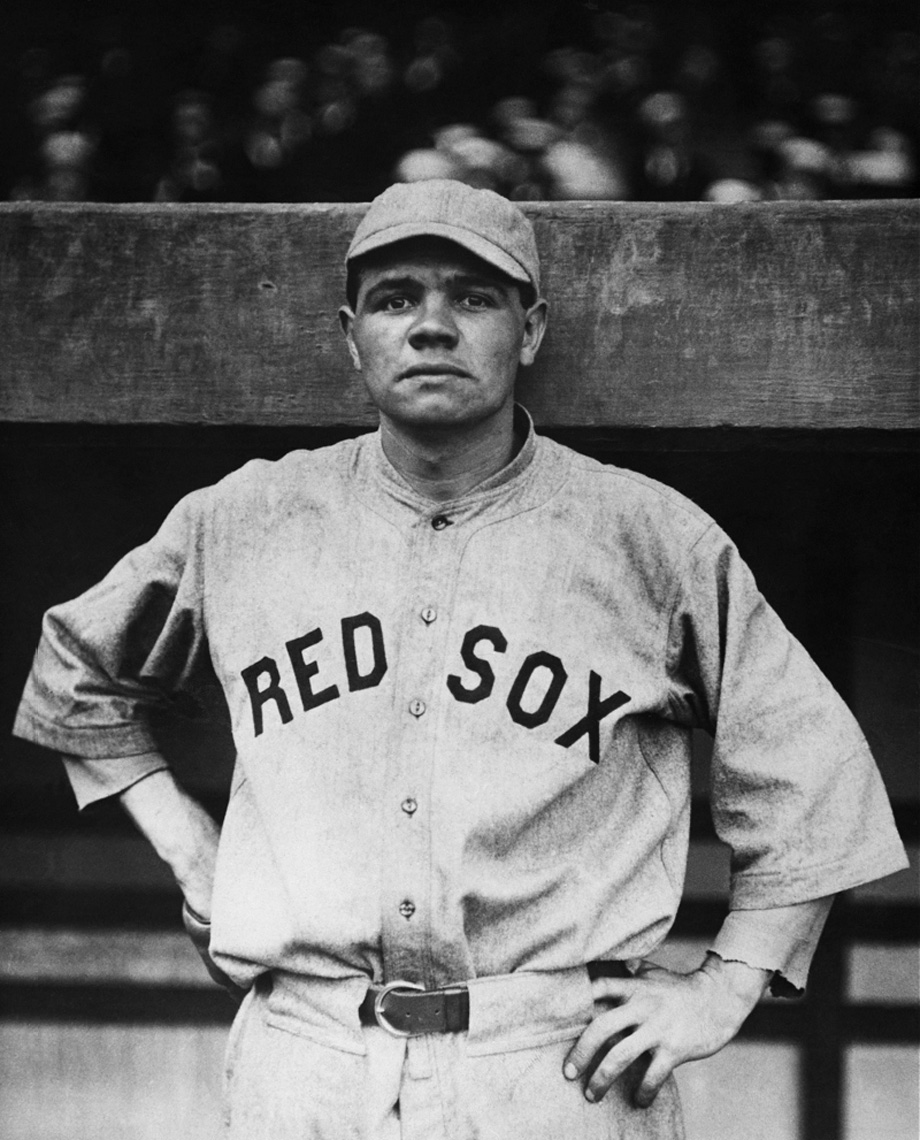May 20, 1919: Babe Ruth clobbers his first career grand slam

When Boston’s 1918 World Series championship season was over, Babe Ruth asked for more money through his new agent, Johnny Igoe, demanding a two-year contract at $15,000 a year. Red Sox owner Harry Frazee, in economic survival mode, responded with an emphatic no.
Negotiations included Frazee’s offer of $8,500 after Igoe insisted on a three-year deal for Babe at $10,000 a year. Ruth said he did not want to both pitch and play left field, that he only wanted to play left and be in the lineup each day.
When Red Sox manager Ed Barrow was asked what he thought, he made it clear who would be in charge of the ballclub on the field: “If Ruth plays for the Red Sox in 1919, he will probably pitch and pinch-hit.”1
Barrow was wrong; Babe would pitch in only 17 games. He would have a breakout year in his final season with Boston before being sold to the Yankees.
Ruth finally signed a contract with Frazee in Boston on March 21, a three-year deal at $10,000 a year, and immediately reported to Tampa, Florida, where Barrow was holding training camp.
In the first game of spring training, on April 4 against the New York Giants, Ruth hit a towering drive to right center that reportedly traveled 579 feet. The club headed north with the Giants before Boston played a two-game series in Ruth’s hometown, Baltimore, against the Orioles.
He was spectacular. In the first game, on April 18, Babe hit four home runs.
“Ruth, only a short while ago unknown to all save his schoolmates at St. Mary’s, among whom he was an idol, proved conclusively to about 2,000 spectators who braced the wintry winds that Harry Frazee has the greatest bargain in the United States,” wrote a sportswriter for the Baltimore Sun. “Of course, the Red Sox, world’s champions all, won, but everyone expected that. The score, which was 12 to 3, really made no difference. The fans went to the ball yard to see if Ruth could hit one over the fence. They got their money’s worth many times over.”2
The next day Ruth was the starting pitcher and was at the plate three times. After slugging two more round-trippers, he was struck out by Orioles lefty Rudy Kneisch on three pitches and Barrow called on Carl Mays in relief with the score 12-1 in favor of Boston.
In the two games Babe finished 6-for-9 from the plate, all six hits home runs.
No matter how Ruth had performed on the field, Barrow had become suspicious of the young slugger’s inclination toward all-night partying. After the third game of the new season on April 28 in Washington, he waited for Ruth in the lobby of the Raleigh Hotel until 4 in the morning before giving up on catching his star’s appearance.
A hotel porter reported to Barrow at 6 A.M. that Ruth had finally come to the hotel, and Barrow confronted Babe, who was fully dressed and smoking a pipe in bed with his covers pulled up to his chin.
“I’ll see you at the ballpark,” Barrow said.
Before that day’s game Ruth challenged his manager, and though the confrontation was averted, it appears that it had some effect on his performance over the next few weeks. His batting average dropped from .316 on May 1 to a low of .180 on May 26, and he had only 11 hits for the season before getting two on May 27 that raised his average to .203.
Ruth’s first pitching performance came on May 3 at Fenway Park against the Yankees and resulted in a complete-game 3-2 victory. Babe had a double and an RBI. On May 15 he was called on in relief of Joe Bush early in the game against the White Sox in Chicago on and gained his second win as Stuffy McInnis drove in Jack Barry with the winning run in the top of the 12th inning.
Either still in Barrow’s doghouse or simply kept out of the lineup due to his weak hitting during a three-game set in Chicago (he had one hit in 11 plate appearances), Ruth pinch-hit for Sad Sam Jones in the eighth inning on May 17 in St. Louis. A paltry roller resulted in an out and catcalls by the fans rang out as St. Louis won, 2-1.3 Ruth did not play in the next day’s game, another victory for the Browns, 4-3.
With the Red Sox’ record 8-8 and four losses in the last five games, Barrow named Babe the starting pitcher on May 20 against the Browns. Sportswriter Melville Webb offered his advice to Boston’s manager.
“It looks now as if ‘Babe’ Ruth would be the fellow relied on to pull out at least one game in the series with the Browns. As time has passed, it has been more and more apparent that the value the club is to get out of ‘Babe’ is in the pitcher’s box. He was held in the game regularly until he failed to hit in form consistent with a regular berth, and the way to get full value on his pitching was for Ed Barrow to stipulate that Ruth make the flinging game strictly his business, for a time at least.”4
Babe took his 2-0 record to the mound against Dave Davenport, who was in his final months in the big leagues. St. Louis manager Jimmy Burke pinned hopes on the 6-foot-6, 220-pound right-hander to continue the Browns’ five-game winning streak.
Ruth won his own cause by smashing Davenport’s first pitch for a home run with two out in the second inning after two runs had scored and Boston loaded the bases. Frank Gilhooley, Barry, and Amos Strunk preceded Ruth across the plate.
“One fast ball, pitched waist high to ‘Babe’ Ruth cost Dave Davenport a victory over the Boston Red Sox in the concluding game of the series at Sportsman’s Park this afternoon and shattered the winning streak of the Browns,” the Boston Globe wrote. “The fast ball served up to Ruth by Davenport came in that inning with two runs across the plate, the bases full and two out. ‘Babe’ swung hard and dropped the ball far on the other side of the right field bleacher wall for a home run, scoring three men ahead of him with what proved to be the decisive runs.
“That one titanic smash ended the offensive activities of the burly Bostonian for the day and he consumed the remainder of the game trying to reduce the hitting of the Browns to a minimum.”5
Ruth gave up nine hits and four runs, walking four and allowing a run to score on a balk.
Ruth “pitched none too strongly, but the insurmountable barrier that his home placed in the path of the Browns proved too much for them to overcome,” the Globe wrote.6
A final newspaper mention of Ruth came in the form of an anecdote: “ ‘One swallow doesn’t make a drunkard’ is an axiom with Dave Davenport, but the tall right-hander admits that one pitched ball to ‘Babe’ Ruth makes a ball game.”7
The grand slam was Babe’s first and he would add three more to set the Red Sox’ single-season record. He hit 15 more grand slams in his career. Interestingly, none were hit in Fenway Park but nine in Yankee Stadium.
Organized Baseball’s first grand slam was hit by Charley Gould of the Boston Red Stockings in an 1871 National Association game, and Roger Connor hit what is accepted as the first major-league grand slam on September 10, 1881, for the Troy Trojans. Neither was a match for Babe Ruth’s total of 16, even though the first line of Connor’s obituary called him “The Babe Ruth of the ’80s” when he died in 1931.8
Ruth’s first grand slam was the 22nd home run of his career and he was on his way to finishing the season with an unheard-of home-run total of 29. The Bambino was off and running toward an amazing career of 714 homers to become an icon in the history of baseball.
Ruth’s career grand slams:
| Date | Opponent | Location | Pitcher |
| With Boston | |||
| May 20, 1919 | St. Louis Browns | St. Louis | Dave Davenport |
| June 30, 1919 (1) | New York Yankees | New York | Bob Shawkey |
| July 18, 1919 | Cleveland Indians | Cleveland | Fritz Coumbe |
| August 23, 1919 | Detroit Tigers | Detroit | Hooks Dauss |
| With New York | |||
| July 6, 1922 (1) | Cleveland Indians | New York | Duster Mails |
| September 24, 1925 | Chicago White Sox | New York | Sarge Connally |
| September 25, 1926 (1) | St. Louis Browns | St. Louis | Elam Vangilder |
| September 27, 1927 | Philadelphia Athletics | New York | Lefty Grove |
| September 29, 1927 | Washington Senators | New York | Paul Hopkins |
| July 3, 1929 | Boston Red Sox | New York | Red Ruffing |
| August 6, 1929 (2) | Washington Senators | New York | Bobby Burke |
| August 7, 1929 (1) | Philadelphia Athletics | Philadelphia | Howard Ehmke |
| September 27, 1930 | Philadelphia Athletics | Philadelphia | George Earnshaw |
| August 20, 1931 | St. Louis Browns | St. Louis | Wally Hebert |
| May 21, 1932 (1) | Washington Senators | New York | Lloyd Brown |
| June 24, 1934 | Chicago White Sox | New York | Sad Sam Jones |
Sources
In addition to the sources cited in the Notes, the author consulted Baseball-Almanac.com, Baseball-Reference.com, Baseballhall.org, Newspapers.com, Retrosheet.org, and Sabr.org, and the following:
Barthel, Thomas. Babe Ruth and the Creation of the Celebrity Athlete (Jefferson, North Carolina: McFarland, 2018).
Stewart, Wayne. Babe Ruth: A Biography (Westport, Connecticut: Greenwood, 2006).
Notes
1 Robert W. Creamer, Babe: The Legend Comes to Life (New York: Simon and Schuster, 1974), 186-187.
2 C. Starr Matthews, “Equals World’s Record,” Baltimore Sun, April 19, 1919: 10.
3 “Red Sox Dazzled by Gallia’s Shoots,” Boston Globe, May 18, 1919: 17.
4 Melvin E. Webb Jr., “Red Sox Must Work Hard to Break Even,” Boston Globe, May 20, 1919: 10.
5 “Bases Loaded, Ruth Clouts Over Fence,” Boston Globe, May 21, 1919: 9.
6 Ibid.
7 Ibid.
8 National Baseball Hall of Fame, “Roger Connor,” baseballhall.org/hall-of-famers/connor-roger. Accessed April 17, 2019.
Additional Stats
Boston Red Sox 6
St. Louis Browns 4
Sportsman’s Park
St. Louis, MO
Box Score + PBP:
Corrections? Additions?
If you can help us improve this game story, contact us.


